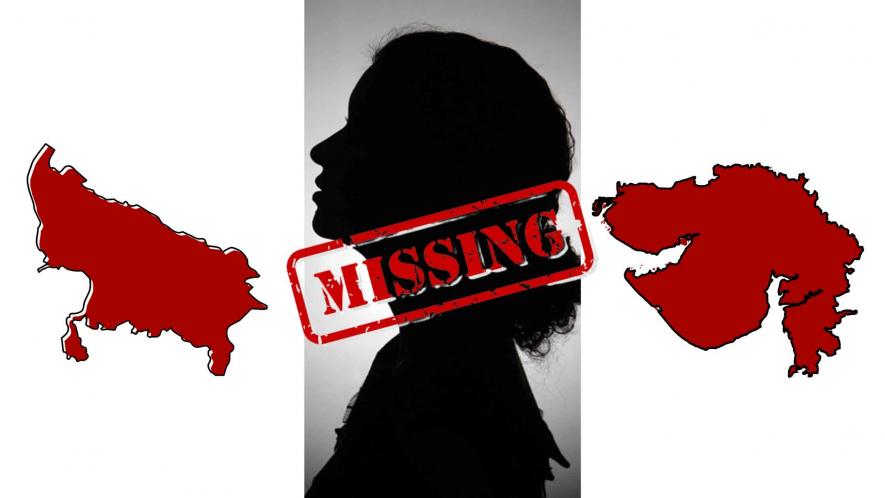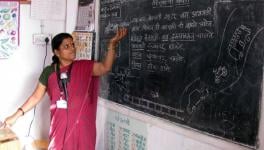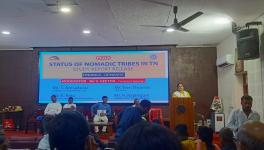Missing Women in Gujarat and Uttar Pradesh

There are nearly 15 million missing women in Uttar Pradesh and almost 5 million in Gujarat1. Are you scandalised to hear that? Let me argue (using data) that this may not be far from the truth.
The Kerala Story and Propaganda
Let us first examine the film The Kerala Story, which exemplifies how propaganda can influence our beliefs. It led us to believe that 30,000 women were missing in Kerala. The success of The Kerala Story can be attributed to our failure to question information and uncover the underlying political motivations.
The Kerala Story, is a propaganda film about missing women in Kerala. Following pressure from the court, the producers have altered the text in the film's teasers on YouTube, changing the statement from 32,000 missing women to three women allegedly brainwashed, converted, and sent on terror missions.
Let us start with what Prime Minister (PM) Modi said about a recent movie during the Karnataka election. He told his audience and the rest of the country about a film, Kerala story.
Modi delivered a pre-poll speech in Ballari, Karnataka, on May 5, where he stated the following:
"In these changing times, the nature of terrorism is also changing …Bombs, rifles and pistols… (have been replaced by) a new type which undermines society from within, makes no sound. The Kerala Story is a film based on one such conspiracy in Kerala".
Prem Shankar Jha, in his column The Wire,
“Just a year after The Kashmir Files, Prime Minister Narendra Modi is once again leveraging another highly provocative film, The Kerala Story, to fuel animosity towards Indian Muslims, aiming to secure the "Hindu" vote and maintain his power in the upcoming year”
"A study by the Manohar Parrikar Institute reveals that by 2019, fewer than 100 migrants in the Gulf were believed to have been lured by ISIS, while 155 individuals in India were arrested for having ISIS connections. The claim of 32,000 recruits from India, particularly a significant number being women, is absurd. European Union and US Central Intelligence Agency estimates put the maximum strength of ISIS at around 30,000 during its peak."
Why Fewer Indians Have Joined ISIS
Low Budgets Films - New Tool for mass propaganda
A new tactic has emerged where low-budget films are used to fuel hatred deliberately, following the success of The Kashmir Files. This is followed by a widespread propaganda campaign through news channels, influencers, articles, and various government branches to amplify and perpetuate this divisive narrative. The goal is to manipulate public sentiment and consolidate power by creating an atmosphere of hostility. The target is a vulnerable section of the Indian population, our Muslims.
Missing Women - A Study of Demographic Data
Let's delve into the concept of "Missing women" as defined by Amartya Sen—an issue that should deeply concern all of us and remain at the forefront of our national consciousness, particularly for the government and Prime Minister Modi, who have championed initiatives like "Beti Bachao, Beti Padhao."
The Sex Ratio indicates the number of females for every 1,000 males in a particular population, revealing insights into gender distribution and societal dynamics. Meanwhile, the Child Sex ratio focuses on children aged 0-6, highlighting gender-based discrimination and practices such as female feticide.
Research suggests that boys tend to outnumber girls at birth by around 105-106 males per 100 females, a consistent pattern noted by Amartya Sen. The reasons behind this disparity are still debated. However, women tend to have a biological advantage over men, with extensive research indicating that women tend to live longer and exhibit better resistance to diseases if they receive similar healthcare, nutrition, and general medical attention. This advantage is observed not only in the later stages of life but also during infancy and even in the womb. Women have higher survival rates when provided with equal care than men.
In regions such as Europe, the United States, and Japan, where women face relatively less essential nutrition and healthcare discrimination, they significantly outnumber men. This discrepancy can be attributed, in part, to social and environmental factors that increase male mortality rates, including violence and smoking-related diseases. However, even after accounting for these factors, women's longer lifespans stem from their biological advantages in disease resistance. Whether the higher frequency of male births has evolutionary links to women's potentially more excellent survival rates is still an interesting topic of study.
Overall, Sen emphasises that women tend to have lower mortality rates than men at various stages of life when given similar treatment in matters of life and death. These findings underscore the importance of addressing gender disparities and ensuring equitable access to healthcare and resources to promote better health outcomes for all.
"Missing women" refers to the gender imbalance resulting from various factors, including gender-based discrimination, female feticide, infanticide, and inadequate access to healthcare and nutrition for women. It highlights the discrepancy between the expected number of females based on natural factors and the observed number, indicating the gender-based discrimination and inequalities prevalent in society. The concept of "missing women" is related to the sex ratio, an indicator of gender distribution and can be calculated for different age groups or the overall population. A sex ratio below 1,000 suggests a lower proportion of females, while a ratio above 1,000 indicates a higher proportion of females. "Missing women" serves as a reminder of the need to address gender disparities and promote gender equality by ensuring equitable access to healthcare and resources for all.
Missing Women - India
Let us study missing women in Indian States using the Sex ratio and some interrelated social metrics to see if we can link the missing women to address gender disparities.
It is important to note that negative values in the "Missing Women" row indicate a surplus of women rather than missing women. These values are calculated by subtracting the sex ratio of each State from 1000.
This table displays data on gender disparities in six Indian states - Kerala, Tamil Nadu, Gujarat, Haryana, Punjab, and Uttar Pradesh. By examining the Sex Ratio and Child Sex Ratio metrics, we can analyse the concept of missing women and compare it to other indicators, providing an academic summary of the states.
-
Missing Women: Missing Women refers to the discrepancy between the expected number of females in a population and the actual number. It serves as a measure of gender disparities and potential discrimination.
-
Kerala exhibits a negative value for missing women, indicating that the actual number of women exceeds the expected number by 84. This suggests a potential overrepresentation of women in the state.
-
Tamil Nadu reports a relatively small value of missing women (4), indicating a close alignment between the expected and actual number of women.
-
Gujarat, Haryana, Punjab, and Uttar Pradesh show higher values of missing women, with Uttar Pradesh reporting the highest (88). These figures indicate a gender imbalance, with the actual number of women falling below the expected number.
The analysis reveals varying degrees of gender disparities among the states. Kerala has a more balanced gender distribution, reflected in its negative value for missing women and a smaller literacy rate gap. The state also demonstrates better maternal healthcare outcomes with a lower MMR.
In contrast, states like Gujarat, Haryana, Punjab, and Uttar Pradesh exhibit more significant gaps in literacy rates, higher MMR values, and positive values for missing women. These findings indicate gender imbalances, potential discrimination against women, and challenges in education and healthcare access.
Kerala -
Other states can learn from Kerala's success in improving sex ratios and addressing gender disparities. Kerala's achievements can be attributed to its focus on critical areas such as literacy, healthcare, and maternal mortality rate (MMR).
-
Literacy: Kerala's emphasis on education and high literacy rates for both genders have contributed to more equitable sex ratios. Other states can prioritise education and ensure equal access to quality education for girls, empowering them and reducing gender disparities.
-
Healthcare: Kerala's robust healthcare infrastructure, particularly maternal and child health, has significantly improved sex ratios. Investing in accessible and quality healthcare services, including reproductive health, can improve health outcomes for women and children in other states.
-
Maternal Mortality Rate (MMR): Kerala's low MMR reflects its focus on maternal healthcare. Other States can learn from Kerala's efforts to improve healthcare access, provide skilled birth attendants, and implement maternal health initiatives to reduce maternal mortality rates and improve overall well-being.
By focusing on literacy, healthcare, and MMR, States can take inspiration from Kerala's approach and work towards achieving better sex ratios and addressing gender disparities.
1Assuming Kerala's sex ratio in Uttar Pradesh and Gujarat, it is estimated that there are 15 million missing women in UP and 5 million in Gujarat.
|
In rural Maharashtra, India, some parents name their daughters Nakusha or Nakushi, which means "unwanted" in Marathi. This is because they see their daughters as unwanted and hope for a boy in the future. |
(The writer is a financial professional, also passionate about the arts, academia, and social issues related to development and human rights)
Get the latest reports & analysis with people's perspective on Protests, movements & deep analytical videos, discussions of the current affairs in your Telegram app. Subscribe to NewsClick's Telegram channel & get Real-Time updates on stories, as they get published on our website.
























